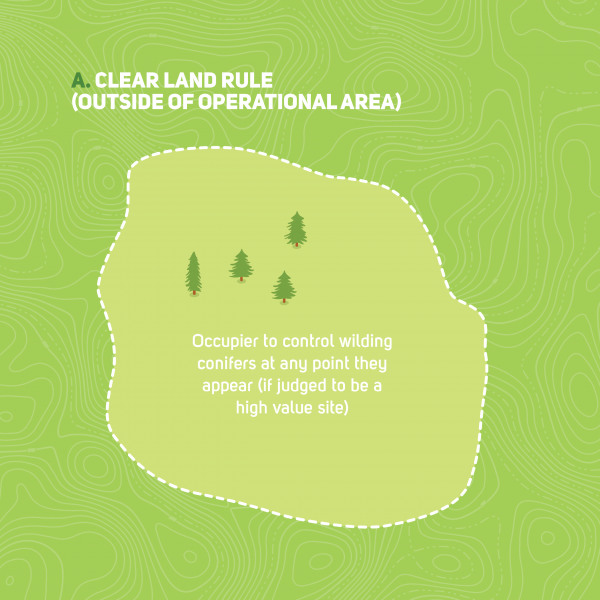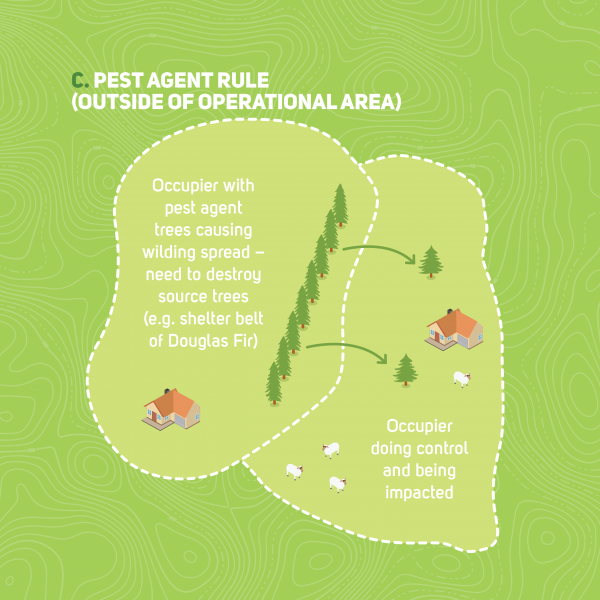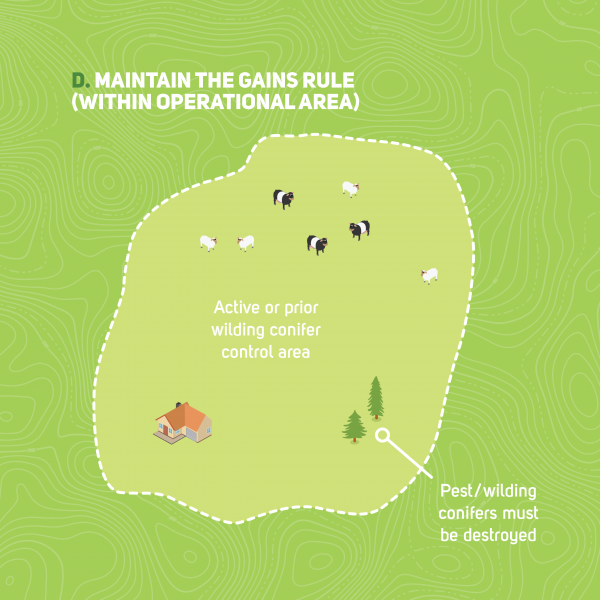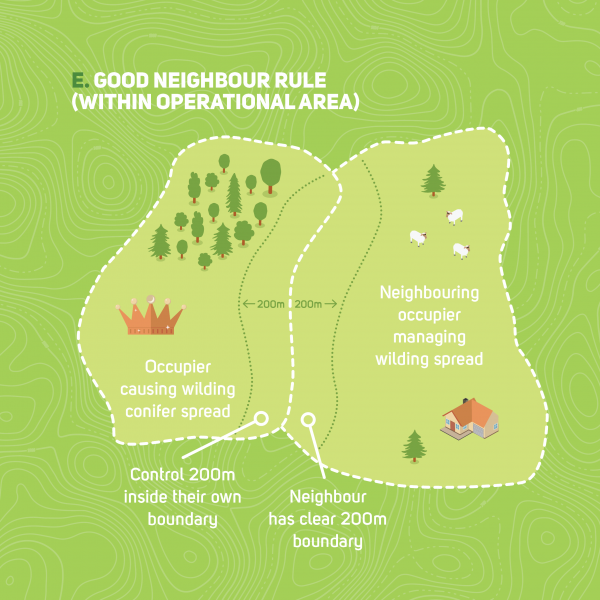There are three region wide rules (outside of Operational Areas):
And two rules regarding operational areas under management
Operational Area is an area currently being managed for the control of wilding conifers under a recognised programme. These areas typically have received taxpayer or ratepayer funding and the rules aim to protect this public investment.
There are 12 conifer species declared pest conifers in the RPMP, as listed in Table 6. Ten individual species are designated pests in any regional situation while the wilding conifer sub-class of subjects covers two species and their pest designations apply only when they occur in wilding states.
Table 6: Subjects of the pest conifer programme
|
Individual subjects |
|
|
Bishops pine (Pinus muricata) |
Maritime pine (Pinus pinaster) |
|
Contorta pine (Pinus contorta) |
Mexican weeping pine (Pinus patula) |
|
Corsican pine (Pinus nigra) |
Ponderosa pine (Pinus ponderosa) |
|
Mountain pine (Pinus mugo) including sub-species and botanical variants |
Scots pine (Pinus sylvestris) |
|
European larch (Larix decidua) and botanical variants |
Western white pine (Pinus monticola) |
|
Class of subjects |
|
|
Wilding conifers Definition ‘Wilding conifers’ - means any introduced conifer tree, including (but not limited to) any of the species listed in the above table, established by self-seeded means, unless it is located within a forest plantation and does not create any greater risk of wilding conifer spread to adjacent or nearby land than the forest plantation that it is a part of. For the purposes of this definition, a forest plantation is an area of 1 hectare or more of predominantly planted conifer trees. Species for the purposes of the wilding conifers class description include (but are not limited to): |
|
|
Douglas fir (Pseudotsuga menziesii) |
Radiata pine (Pinus radiata) |

A. Region wide rule - Occupiers of a site must destroy all pest conifers present on land they occupy, unless the land they occupy falls within a named pest conifer operational area, urban areas or areas of high intensity land use (as determined by an authorised person), or unless there is a negotiated agreement in place between the Management Agency and occupier as an alternative way to achieve this requirement.
‘Clear land’ is defined as parts of the region that are currently clear, (or infestations are at a low or very low density), but highly susceptible to wilding conifer spread if a seed source becomes established. Although the majority of wilding conifer spread is predictable, a characteristic of spread (particularly in highly susceptible areas) is also the occurrence of random, irregular, long distance spread into areas previously unaffected. This rule provides an early intervention trigger for these vulnerable or susceptible areas. Further, protected ‘specimen’ conifer trees named in District Plans (made under the Resource Management Act) may be exempt from this requirement, on a case by case basis.
Example: A landowner has a QEII covenanted block of native forest on his land. He notices several Larch and Douglas fir saplings emerging in the forest. The farmer is required to control these before they produce seed.

B. Region wide rule - From 1 July 2024, occupiers of forest plantations (greater than 1 hectare), outside of named pest conifer operational areas, are liable for the costs of removal of any new wilding conifers present (i.e. subsequently occurring) on adjoining land (where that land is clear of any infestation of wilding conifers as of 30 June 2024 and it is being actively controlled). This requirement is limited to adjoining land within 200m of the forest plantation property’s boundary and the adjoining occupier must be taking reasonable steps to control wilding conifers elsewhere on the property. This obligation will be on written direction from an authorised person, following a complaint from an adjoining affected neighbour, and where there is evidence that wilding spread has occurred from the planted forest to an adjoining property. A negotiated agreement between the Management Agency and the two occupier parties is an alternative way to achieve this agreement.
Example: A farm in the Howard Valley adjoins a TDC forestry block. The farmer has had issues with pine trees seeding on to his property for some years, but has not ignored the problem and is actively managing the control of the wilding pines on his land right up to his boundary with the plantation forest. His land needs to be relatively clear of pines for this rule to apply and it is clear to an Authorised Council officer that control work has, and is being done. As of the 1 July 2024, any new seedlings from the TDC forestry block that occur within a 200 m margin on the farmer’s property are required to be controlled by the TDC forestry manager. The method of control can vary depending on the circumstance.
The process for Council staff is the same as when assessing gorse boundary issues

C. Region wide rule - Occupiers must destroy any pest agent conifer on their land, on direction of an authorised person, where an adjoining occupier is taking reasonable steps to control wilding conifers on their land and that evidence of wilding spread is clearly attributable to the pest agent conifer(s), or there is a negotiated agreement in place between the Management Agency and occupier as an alternative way to achieve this requirement.
Example: A Douglas fir shelter belt is creating a wilding conifer issue for a neighbouring farm. A meeting takes place with the landowner that has the shelter belt, the affected land owner and a Council officer to discuss the issue. An agreement is reached to keep the trees trimmed over the next five years so that fewer cones are produced. It is also agreed to interplant macrocarpa trees among the Douglas fir trees. After five years, the Douglas fir trees will then be felled, leaving the macrocarpa trees as replacements.
Example: A Douglas fir shelter belt is creating a wilding conifer issue for a neighbouring farm. The two neighbours catch up and come to an agreement that the owner of the shelterbelt will help their neighbour control the wildings in the next door paddock once a year. Council staff don’t get involved.

D. Operational area rule - Occupiers must destroy any pest conifers on their land where the property is located within one of the four named operational areas that has received prior control, or there is a negotiated agreement in place between the Management Agency and occupier as an alternative way to achieve this requirement. This rule does not imply any obligations on occupiers of planted forests of species not listed as pest conifers and does not apply until a property has received initial and maintenance control, as described below.
Example: Its 2027 and Project De-vine has been controlling wilding pines on a private property with the support of some national funding and the landowner. They have visited the property 3 times over the years and are now only finding the odd seedling. The landowner is now required to continue the control as the seedlings appear.

E. Operational area rule - Occupiers within any of the four named operational areas must destroy any pest conifers on their land within 200m of an adjoining property boundary, where the adjoining property has previously been cleared of pest conifers through prior control and the adjoining occupier is also taking reasonable steps to control pest conifers within 200m of their property boundary. This is a Good Neighbour Rule (GNR) and will apply unless there is a negotiated agreement in place between the Management Agency and occupier as an alternative way to achieve this requirement.
Example: A neighbouring farmer to Nelson Lakes National Park is within an operational area but is having to control wilding conifer seed which is sourced from a strip of wilding pine trees growing on DOC land. These pine trees are growing right up to the boundary fence and are about 400 metres wide in places. Under the new good neighbour rule, there is an obligation for DOC to clear a 200m strip of these pine trees back from the boundary, while-ever the farmer has a strip clear on his property of 200m back from the fence into his property.
An assumption is made that current priority control areas and programmes (included in the National Wilding Conifer Control Programme) will continue to be funded until the ‘back of each problem’ is broken (i.e. no coning trees remain on target properties) and responsibility for ongoing control can be transitioned (i.e. transferred) back to individual land occupiers to manage into the future. ‘Transitional criteria’ nationally at the time of writing were not fully agreed, however the following rules would not be implemented until an operational area had received initial control and up to 2-3 rounds of maintenance control (with varying years, i.e. typically 3-5 years, between control cycles, dependant on the species).
There are four pest conifer control operational areas in Tasman-Nelson which are the subject of this sub-programme. There are two rules:
Specific rules applicable across parts of the region (as listed below):
Over the duration of this Plan, control is required within the above operational areas under current management, in the Tasman-Nelson region (as shown in Maps) and prior to cone bearing.
There are 12 conifer species declared pest conifers in the RPMP, as listed in Table 6. Ten individual species are designated pests in any regional situation while the wilding conifer sub-class of subjects covers two species, (Douglas fir and radiata pine) and their pest designations apply only when they occur in wilding states.
The purpose of these rules is in accordance with sections 73(5)(h), as outlined below:
A four-step process is followed to enact the rule:
Step 1: Complaint received by council.
Step 2: Complaint investigated by an appropriate Authorised Person (with powers of entry) to validate complaint.
Step 3: Meeting held between the parties to engage with them and to reach a negotiated agreement.
Step 4: If no agreement can be reached, RPMP enforcement provisions may be enacted.
A negotiated agreement between the forest occupier and adjoining occupier (and validated by the Management Agency) will be a binding way to meet this rule requirement, e.g. that the agreement documents which party will undertake and/or fund the required control, over what time period and what the access agreements are to carry out control work.
Download the Pest Conifer Progressive Containment Area Maps. (pdf 2.7 MB)
Last modified: